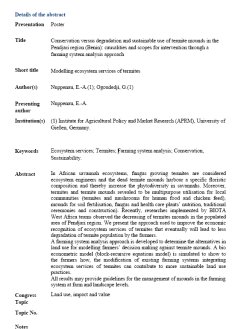| Details of the presentation |
| Presentation |
Poster presentation |
| Title |
Conservation versus degradation and sustainable use of termite mounds in the Pendjari region (Benin): causalities and scopes for intervention through a farming system analysis approach
|
| PDF Download |
 Download PDF (Filesize 9 kByte)
Download PDF (Filesize 9 kByte)

|
| Short title |
Modelling ecosystem services of termites
|
| Author(s) |
Nuppenau, E.-A.(1); Ogoudedji, G.(1)
|
| Presenting author |
Nuppenau, E.-A.
|
| Institution(s) |
(1) Institute for Agricultural Policy and Market Research (APRM), University of Gießen, Germany.
|
| Keywords |
Ecosystem services; termites; Farming system analysis; conservation, sustainability.
|
| Abstract |
In African savannah ecosystems, fungus growing termites are considered ecosystem engineers and the dead termite mounds harbour a specific floristic composition and thereby increase the phytodiversity in savannahs. Moreover, termites and termite mounds revealed to be multipurpose utilisation for local communities (termites and mushrooms for human food and chicken feed), mounds for soil fertilisation, fungus and health care plants’ nutrition, traditional ceremonies and construction). Recently, researches implemented by BIOTA West Africa teams observed the decreasing of termites mounds in the populated area of Pendjari region. We present the approach used to improve the economic recognition of ecosystem services of termites that eventually will lead to less degradation of termite population by the farmers.
A farming system analysis approach is developed to determine the alternatives in land use for modelling farmers’ decision making against termite mounds. An bio econometric model is simulated to show to the farmers how, the modification of existing farming systems integrating ecosystem services of termites can contribute to more sustainable land use practices.
All results may provide guidelines for the management of mounds in the farming system at farm and landscape levels.
|
| Congress Topic |
Land use, impact and value
|
| Topic No. |
--- |
| Notes |
---
|
| Ref. No. |
652 |
